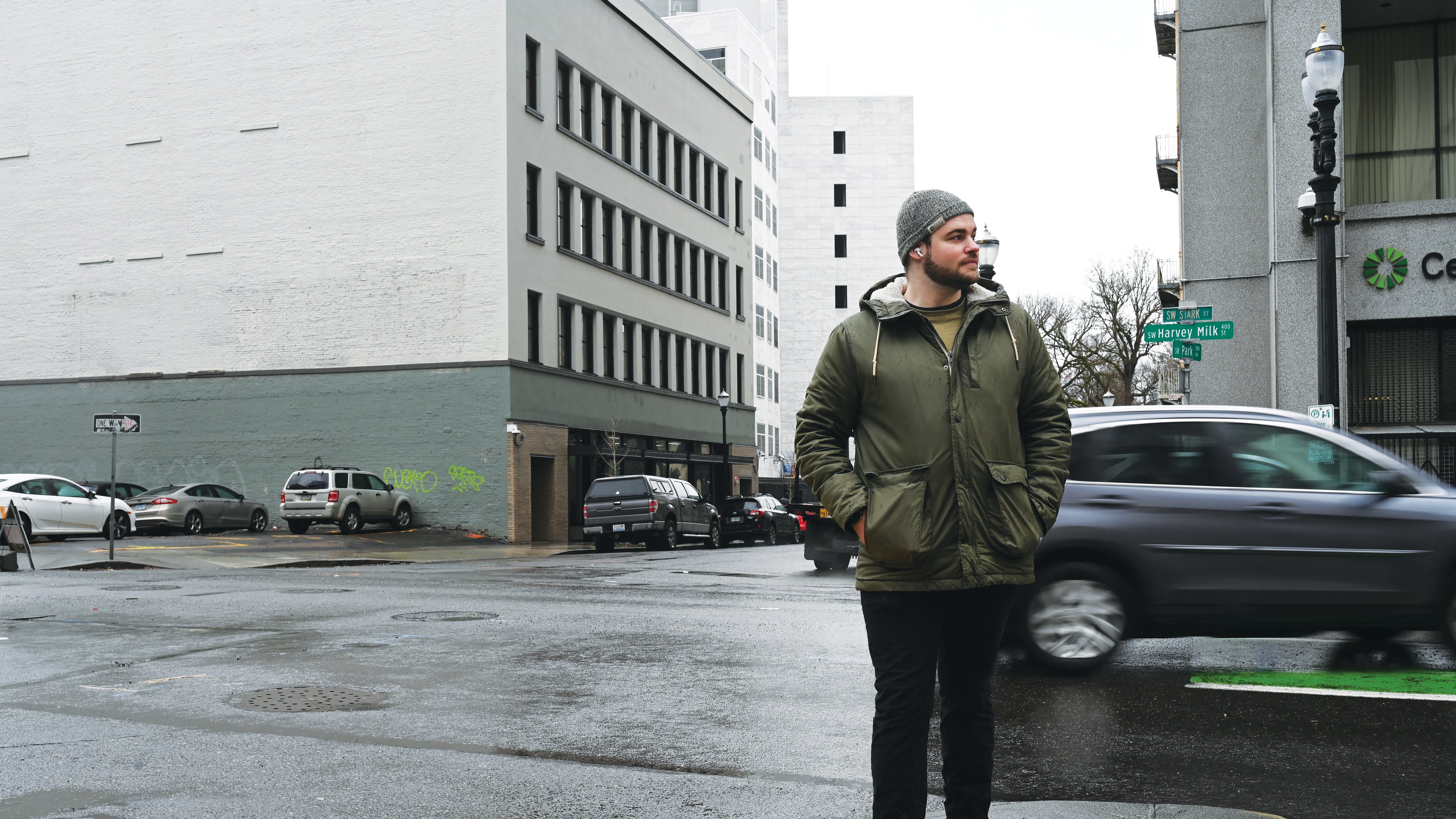Steve Herring pleaded with Multnomah County commissioners for help, his voice quivering.
“Our existence is on the line in terms of our continued place in downtown Portland,” the CEO of Living Room Theaters told them. “We’re in dire, dire straits.”
Herring was speaking last month of the county’s new Behavioral Health Resource Center on Southwest Park Avenue between Oak and Harvey Milk streets. Two blocks east of Herring’s fiveplex cinema, it offers homeless Portlanders a place to shower, eat, wash laundry, browse the web, patch up wounds or just hang out. It opened Dec. 5.
Every morning, a line stretches for a block before the center opens at 8 am, down-and-out Portlanders awaiting entrance to a squat building located among the Dossier, the Hyatt and, soon, the 35-story Ritz-Carlton, by far the most expensive hotel Portland has ever seen.
And those business owners are asking the county to do more to keep the neighborhood around the center free from some of what its clients bring with them, including threats of violence and drug use. They’ve requested security patrols, police drug stings, and a fundamental alteration of the center’s operating model.
The tensions underlie a more complicated question: How do officials serve homeless Portlanders in the heart of downtown without deterring the customers businesses desperately need?
Business reps painted a bleak picture.
“Staff members have been held at gunpoint, clients that we’ve relied on for years have turned away from downtown,” Matthew Skelton, manager of Hotel Lucia, a block east on Southwest Broadway, told the board Feb. 16. “Clients have been robbed.”
The county says it won’t change the center’s walk-in model because it’s meant for Portlanders for whom even a phone call to schedule an appointment can pose an impossible barrier.
“We have heard time and again that an appointment-based model will not work for those suffering from behavioral health challenges and living on our streets,” says Sara Guest, spokeswoman for County Chair Jessica Vega Pederson. “So we are striving for a system with no wrong doors. We will continue to uphold that model.”
The four-story center is the brainchild of former County Chair Deborah Kafoury, who helped haul the first-of-its-kind project across the finish line before she left office. It serves more than 1,100 Portlanders a week, according to county officials. In a week’s time, 200 people scrub themselves in showers. Washing machines spin 140 loads of laundry. Since mid-January, center staff has referred 207 people to mental health services.
The county hired Mental Health & Addiction Association of Oregon to run the center. It’s staffed by more than two dozen peer specialists who themselves once struggled with addiction or homelessness.
Lockers keep visitors’ few possessions safe. There’s no pressure to leave until closing time at 8 pm. A woman told staff on Monday that the shower she took on the second floor of the center was the first she’d had since she became homeless, says center director Zach Harrell.
That’s the success story, among numerous others Harrell could tell. Surrounding shopkeepers tell another tale.
Rewind to the months prior to the center’s December ribbon-cutting and a familiar story arc played out behind closed doors: Business owners were anxious that the center would be a magnet for drug dealing, tent camping, and erratic behavior. They say Kafoury’s staff blew off their concerns.
“The building is where the need is,” says Christa Jones, the county’s community mental health program manager. But she acknowledges it’s not ideal for surrounding businesses: “I have all the compassion for them. It’s not conveniently placed for them. I understand that.”
And those businesses say their fears have come true.
Employees at the UnderU4Men underwear store down Park Avenue from the center now each wear a mini pepper spray canister hooked to a belt loop. The owner purchased them after a sidewalk brawl tumbled into the store.
“We have a store Taser, and we have a larger, 40-burst pepper spray for the store,” says store manager Wes Bateman. “Three times a day, we have people outside doing drug deals. I feel like the dealers knew this is an easy market.”
Operators of the Union Bank Tower kitty-corner from the center, on Southwest Washington Street, have kept a log to trace a correlation between the center’s opening and incidents of loitering, property damage and drug use outside. Security staff recorded seven incidents in the first week of November, before the center opened; it recorded 55 incidents last week.
Earlier this month, the owners of the Union Bank Tower hired armed security guards from Echelon Protective Services to patrol.
Nearby businesses and government officials are approaching yet another draft of a nonbinding “good neighbor” agreement that sets mutual expectations for the two parties. County officials say one item is nonnegotiable: The center’s walk-in model will remain.
But the county insists it’s made small tweaks to improve conditions outside the center. Plainclothes security guards that once roamed inside the building and around the block now wear uniforms, for instance, after center visitors responded overwhelmingly in a survey that they’d feel safer with uniformed guards.
Director Harrell says the center tells visitors they won’t be allowed to come inside if they pitch tents within two blocks of the center. “It feels icky and harsh,” he says, “but we really want to respect our neighbors.”
Harrell says he’s confronted several suspected drug dealers inside the center, telling them, “We won’t allow you back in.” And Harrell lowered the center’s capacity from 150 people down to 75 just weeks after it opened. (It’s now back up to 100.)
Some onlookers are skeptical that businesses and a behavioral health center can ever coexist without one sabotaging the other.
“I’ve been listening to this for three years, and it’s ridiculous,” says George Schweitzer, an executive with the company that owns the Benson Hotel, around the block from the center, on Broadway. “It’s all happy talk.”
Jones, the county’s mental health manager, says she’s hopeful there’s a scenario where both businesses and the center can succeed.
“If there’s an assumption that the [center] is the central cause of what we’re seeing, then I don’t know what the appetite is to have a center like that even on the best days,” Jones says. “But we’re getting needs met. This was exactly what it was intended to do.”
In late spring, two new types of residents will move into the area. Nineteen people will take up beds on the fourth floor until the county finds them permanent housing. Another 33 people will take turns staying overnight on the third floor.
Just a block and a half away, 130 people will begin moving into the Ritz-Carlton, where condos run from $2 million to $9 million. The hotel will also open 250 rooms, starting at $518 per night.
That means Portland’s 1% will live steps away from the city’s most downtrodden. No one knows how the two worlds will affect one another.

